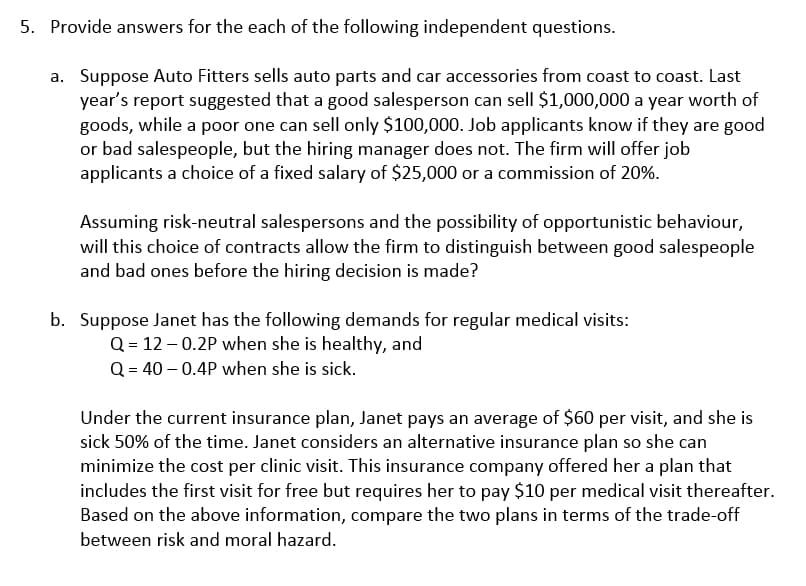5. Provide answers for the each of the following independent questions. a. Suppose Auto Fitters sells auto parts and car accessories from coast to coast. Last year's report suggested that a good salesperson can sell $1,000,000 a year worth of goods, while a poor one can sell only $100,000. Job applicants know if they are good or bad salespeople, but the hiring manager does not. The firm will offer job applicants a choice of a fixed salary of $25,000 or a commission of 20%. Assuming risk-neutral salespersons and the possibility of opportunistic behaviour, will this choice of contracts allow the firm to distinguish between good salespeople and bad ones before the hiring decision is made? b. Suppose Janet has the following demands for regular medical visits: Q = 12 – 0.2P when she is healthy, and Q = 40 – 0.4P when she is sick. Under the current insurance plan, Janet pays an average of $60 per visit, and she is sick 50% of the time. Janet considers an alternative insurance plan so she can minimize the cost per clinic visit. This insurance company offered her a plan that includes the first visit for free but requires her to pay $10 per medical visit thereafter. Based on the above information, compare the two plans in terms of the trade-off between risk and moral hazard.
5. Provide answers for the each of the following independent questions. a. Suppose Auto Fitters sells auto parts and car accessories from coast to coast. Last year's report suggested that a good salesperson can sell $1,000,000 a year worth of goods, while a poor one can sell only $100,000. Job applicants know if they are good or bad salespeople, but the hiring manager does not. The firm will offer job applicants a choice of a fixed salary of $25,000 or a commission of 20%. Assuming risk-neutral salespersons and the possibility of opportunistic behaviour, will this choice of contracts allow the firm to distinguish between good salespeople and bad ones before the hiring decision is made? b. Suppose Janet has the following demands for regular medical visits: Q = 12 – 0.2P when she is healthy, and Q = 40 – 0.4P when she is sick. Under the current insurance plan, Janet pays an average of $60 per visit, and she is sick 50% of the time. Janet considers an alternative insurance plan so she can minimize the cost per clinic visit. This insurance company offered her a plan that includes the first visit for free but requires her to pay $10 per medical visit thereafter. Based on the above information, compare the two plans in terms of the trade-off between risk and moral hazard.
Principles of Microeconomics (MindTap Course List)
8th Edition
ISBN:9781305971493
Author:N. Gregory Mankiw
Publisher:N. Gregory Mankiw
Chapter19: Earnings And Discrimination
Section: Chapter Questions
Problem 8PA
Related questions
Question

Transcribed Image Text:5. Provide answers for the each of the following independent questions.
a. Suppose Auto Fitters sells auto parts and car accessories from coast to coast. Last
year's report suggested that a good salesperson can sell $1,000,000 a year worth of
goods, while a poor one can sell only $100,000. Job applicants know if they are good
or bad salespeople, but the hiring manager does not. The firm will offer job
applicants a choice of a fixed salary of $25,000 or a commission of 20%.
Assuming risk-neutral salespersons and the possibility of opportunistic behaviour,
will this choice of contracts allow the firm to distinguish between good salespeople
and bad ones before the hiring decision is made?
b. Suppose Janet has the following demands for regular medical visits:
Q = 12 – 0.2P when she is healthy, and
Q = 40 – 0.4P when she is sick.
Under the current insurance plan, Janet pays an average of $60 per visit, and she is
sick 50% of the time. Janet considers an alternative insurance plan so she can
minimize the cost per clinic visit. This insurance company offered her a plan that
includes the first visit for free but requires her to pay $10 per medical visit thereafter.
Based on the above information, compare the two plans in terms of the trade-off
between risk and moral hazard.
Expert Solution
This question has been solved!
Explore an expertly crafted, step-by-step solution for a thorough understanding of key concepts.
Step by step
Solved in 2 steps

Knowledge Booster
Learn more about
Need a deep-dive on the concept behind this application? Look no further. Learn more about this topic, economics and related others by exploring similar questions and additional content below.Recommended textbooks for you

Principles of Microeconomics (MindTap Course List)
Economics
ISBN:
9781305971493
Author:
N. Gregory Mankiw
Publisher:
Cengage Learning

Principles of Economics, 7th Edition (MindTap Cou…
Economics
ISBN:
9781285165875
Author:
N. Gregory Mankiw
Publisher:
Cengage Learning

Principles of Economics (MindTap Course List)
Economics
ISBN:
9781305585126
Author:
N. Gregory Mankiw
Publisher:
Cengage Learning

Principles of Microeconomics (MindTap Course List)
Economics
ISBN:
9781305971493
Author:
N. Gregory Mankiw
Publisher:
Cengage Learning

Principles of Economics, 7th Edition (MindTap Cou…
Economics
ISBN:
9781285165875
Author:
N. Gregory Mankiw
Publisher:
Cengage Learning

Principles of Economics (MindTap Course List)
Economics
ISBN:
9781305585126
Author:
N. Gregory Mankiw
Publisher:
Cengage Learning


Principles of Microeconomics
Economics
ISBN:
9781305156050
Author:
N. Gregory Mankiw
Publisher:
Cengage Learning

Principles of Economics 2e
Economics
ISBN:
9781947172364
Author:
Steven A. Greenlaw; David Shapiro
Publisher:
OpenStax